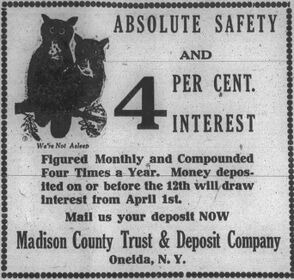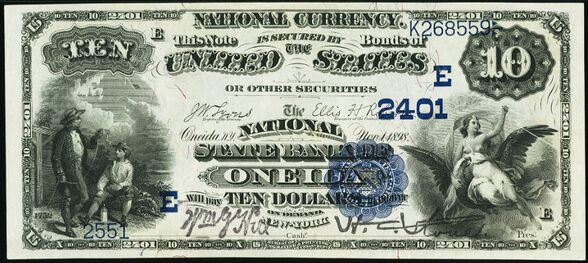National State Bank, Oneida, NY (Charter 2401)

National State Bank, Oneida, NY (Chartered 1878 - Liquidated 1913)
Town History
Oneida (/oʊˈnaɪdə/) is a city in Madison County located west of Oneida Castle (in Oneida County) and east of Wampsville, New York. The population was 11,390 at the 2010 census. The city, like both Oneida County and the nearby silver and china maker, was named for the Oneida tribe, which had a large territory here around Oneida Lake during the colonial period.
This area was part of the territory of the Oneida tribe during the colonial era. The Oneida were one of the original Five Nations of the Iroquois League and many Oneida were allies of the Americans during the Revolutionary War, although the Onondaga, Cayuga, Seneca and Mohawk tribes led by Mohawk Chief Joseph Brant, who fought for the British out of Niagara, decimated several isolated American settlements. Returning to their homes after the Revolution, the Oneida men who served and supported the American effort were compensated by the U.S. government for their losses and took in remnants of the Mohegan nation.
The federally recognized Oneida Nation owns land in this vicinity, where some members live. It operates the Turning Stone Casino and Resort in Verona. It is one of four recognized tribes of Oneida people, the only one in the state.
About 1830, Sands Higinbotham purchased several hundred acres of land where Oneida is now located, and in the autumn of 1834, he took up residence there. In 1837, the Syracuse and Utica Railroad Company located their railroad across from his farm, and made one of their important stations there. In July, 1839, the cars commenced to run and from that date, under the fostering care of Mr. Higinbotham, the village of Oneida has steadily grown.
The Village of Oneida was incorporated on June 20, 1848 as part of the larger Town of Lenox to its west, but years of friction among the different sections of town spurred this village to establish itself independently as the new Town of Oneida in 1896. In turn, this town was later chartered as the City of Oneida on March 28, 1901.
Oneida had three National Banks chartered during the Bank Note Era, and all three of those banks issued National Bank Notes. Oneida also had one Obsolete Bank that issued Obsolete Bank Notes during the Obsolete Bank Note Era (1782-1866).
Bank History
- Organized October 31, 1878
- Chartered November 9, 1878
- Succeeded State Bank
- Liquidated September 1, 1913
- Succeeded by Madison County Trust and Deposit Company
In April 1874, the State Bank of Oneida completed its organization.[2]
In March 1877, S.H. Fox of Durhamville, president of the State Bank in Oneida, was chosen one of the vice presidents of the National Association of Window Glass Manufacturors, an organization recently formed at Pittsburgh, Pennsylvania.[3]
In December 1888, Hon. Samuel H. Fox was lying at the point of death at his home in Durhamville. He had been out of health for six months, but had been about his business till last week. Samuel Hamilton Fox was born at Nassau, Rensselaer County, New York, April 20, 1815. He was the son of Isaac B. Fox, a large manufacturer of satinets. Isaac B. Fox in 1818, purchased the glass factory at Sand Lake near Troy and moved with his family to Sand Lake. This factory was carried on by Samuel H. Fox when be reached his majority, being associated with his brother, State Senator Albert R. Fox. In 1815 the Sand Lake Company bought the factory at Durhamville, of De Witt C. Stephens. The firm was Fox, Gregory & Co., the members being Samuel H. Fox, John H. Gregory, a brother-in-law, and I. Willard Fox. Henry W. Fox afterward became member, succeeding Mr. Gregory, who withdrew. I. Willard Fox retired in 1857 and Henry W. in 1875, and thereafter the business was continued by Samuel H. Fox and his son Fred H., under the name of Fox & Co. until February 1883, when an assignment was made to Hon. Charles S. Symonds, cashier of the Utica City National Bank. The business had grown to great proportions, having 30 pots and employing about 200 hands, most of them skilled mechanics. Its production was about 20,000 boxes or over 6,000,000 square feet of glass per year. Mr. Fox was progressive and energetic in his business. He was the first manufacturer in this country to use soda ash in the making of glass, the first to adopt wheel ovens, and the first man in the state to use coal in his furnaces. The pay roll of the house was about $16,000 a month and the establishment was the largest of the kind in the state. The business passed into the hands of a corporation, when the establishment was burned. It was rebuilt on a smaller scale, and conducted by Mrs. Fox until the present month, when it was sold to Mr. M.B. DeLong of Utica. Mr. Fox led a useful and busy life. A kindly and genial man, he always was held in high esteem by all who knew him. In 1881 he ran for state senator on the Republican ticket, and in 1882 for member of Congress, but was defeated on both occasions.[4]
In January 1908, at the annual election of the National State Bank, the following directors were selected: Andrew J. French, Crawford Getman, Austin B. French, William W. Warr, and Harry C. Stone. The directors elected the following officers: Andrew J. French, president; William W. Warr, vice president; and Austin B. French, cashier. The inspectors elected were Howard L. Baldwin and William G. Hill.[5]
The National State Bank voted to liquidate its affairs on September 1st and to sell its banking property to the Madison County Trust & Deposit Co. The trust company voted to purchase the bank property for $15,000, assuming possession at once. The new owners of the property planned to spend upwards of $10,000 in transforming the bank building into one of the finest and most modern banking houses in central New York.[6]
On November 28, 1917, Crawford Getman, once the greatest manufacturer of window glass in this country, died at his home in Cleveland, New York. He was 84 years old.[7]
Official Bank Title
1: The National State Bank of Oneida, NY
Bank Note Types Issued
A total of $825,770 in National Bank Notes was issued by this bank between 1878 and 1913. This consisted of a total of 113,740 notes (113,740 large size and No small size notes).
This bank issued the following Types and Denominations of bank notes:
Series/Type Sheet/Denoms Serial#s Sheet Comments Series 1875 4x5 1 - 19866 1882 Brown Back 3x10-20 1 - 5400 1882 Date Back 3x10-20 1 - 3169
Bank Presidents and Cashiers
Bank Presidents and Cashiers during the National Bank Note Era (1878 - 1913):
Presidents:
- Samuel H. Fox, 1879-1882
- Stephen Head Farnam, 1883-1897
- Andrew Jackson French, 1898-1908
- Crawford Getman, 1909-1913
Cashiers:
Other Bank Note Signers
- Harry Calvin Stone, Vice President ~1912
Wiki Links
- New York Bank Note History
- General information on Oneida (Wikipedia)
- General information on Madison County (Wikipedia)
- General information on New York (Wikipedia)
Sources
- Oneida, NY, on Wikipedia
- Don C. Kelly, National Bank Notes, A Guide with Prices. 6th Edition (Oxford, OH: The Paper Money Institute, 2008).
- Dean Oakes and John Hickman, Standard Catalog of National Bank Notes. 2nd Edition (Iola, WI: Krause Publications, 1990).
- Banks & Bankers Historical Database (1782-1935), https://spmc.org/bank-note-history-project
- ↑ Daily Sentinel, Rome, NY, Thu., Apr. 1, 1915.
- ↑ Rome Sentinel, Rome, NY, Tue., Apr. 14, 1874.
- ↑ Rome Sentinel, Rome, NY, Tue., Mar. 27, 1877.
- ↑ Daily Sentinel, Rome, NY, Tue., Dec. 18, 1888.
- ↑ Syracuse Herald-Journal, Syracuse, NY, Sat., Jan. 18, 1908.
- ↑ Daily Sentinel, Rome, NY, Fri., Mar. 28, 1913.
- ↑ Democrat and Chronicle, Rochester, NY, Thu., Nov. 29, 1917.

